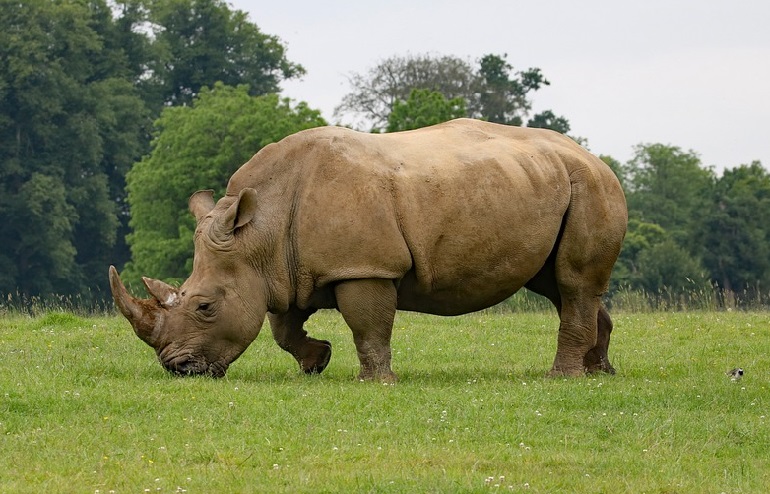Overview
There are only a few animals on this planet, more impressive than the rhinoceros. With their horned noses, large bodies, immense strength, and thick skin – you could be forgiven for thinking they are some kind of dinosaur!
Despite their appearance, most rhino species are pretty laid back. They are rarely aggressive, spending their days roaming around, chomping on grasses and plants.
Sadly, the rhino population is decreasing at a frightening rate, making them one of the most endangered animals. They are frequently killed by persistent poaching, and human activities are rapidly destroying their habitat.
There is still a chance that we can save these wonderful creatures from extinction, but we need to act fast. Read on to find out all you ever wished to know about rhinos and how you can help protect them.
Rhinoceros Physical Appearance and Size
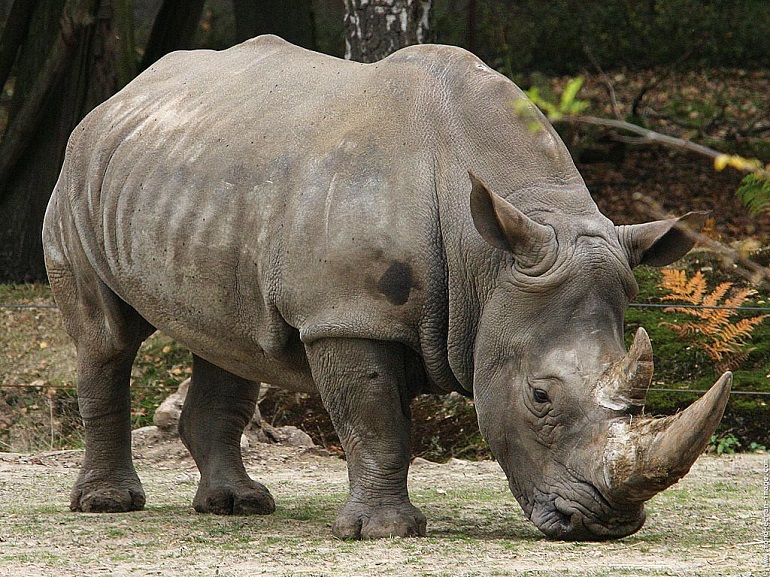
One of the most striking features of the rhinoceros is its horn. In fact, the name “rhinoceros” is a combination of Greek words. “Rhino” means “nose,” and “ceros” means “horn.”
Not all Rhinos have the same number of horns. For example, African species and Sumatran Rhinos have two horns, but the Javan rhino has one horn.
All rhinos have very thick skin; however, it is also very sensitive. Their blood vessels are extremely close to the skin’s surface, so they can feel the irritation caused by insect bites.
They are even vulnerable to sunburn! So to protect their skin, rhinos will soak in mud wallows or roll around in the dust. It’s almost like a rhino beauty routine!
In terms of size, some species are larger and heavier than others. Sumatran rhinos are the smallest. They have an average height of 3.3 to 5 feet and are around 6-13 feet long. They weigh between 1300 and 2090 pounds.
Javan rhinos are a little larger. This species can reach 5.8 feet in height and weigh up to 5000 pounds.
The White rhino, an African species, is the largest. This type of rhino can stand at 6 feet tall and weigh an impressive 7,900 pounds! The Black rhino is the smallest of the two African species. This rhino is around 5.2 feet tall and weighs between 1720 to 3080 pounds.
Interestingly, the White and Black rhino are actually the same color – brownish-gray.
Aside from the modest size differences, their main distinguishing feature is their lips. White rhinos have a square-shaped lip more suited for grazing, while black rhinos have a pointed-shaped lip that helps them to grasp leaves from bushes and trees.
Both Black and White rhinos have two horns but appear slightly different. The Black rhino’s horns are closer together, while the White rhino has more space between them. In both species, the rear horn is slightly smaller.
Taxonomy and Naming
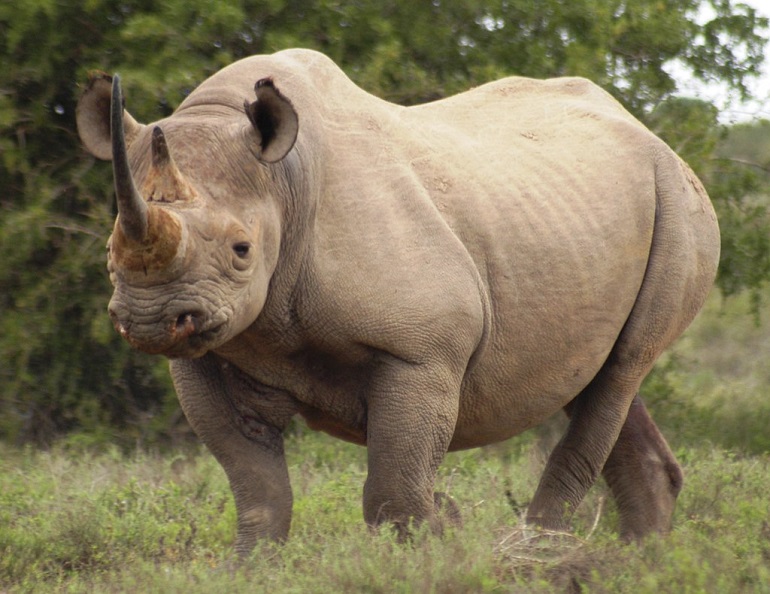
Given below is a complete overview of the rhino populations’ taxonomy and etymology.
Evolution
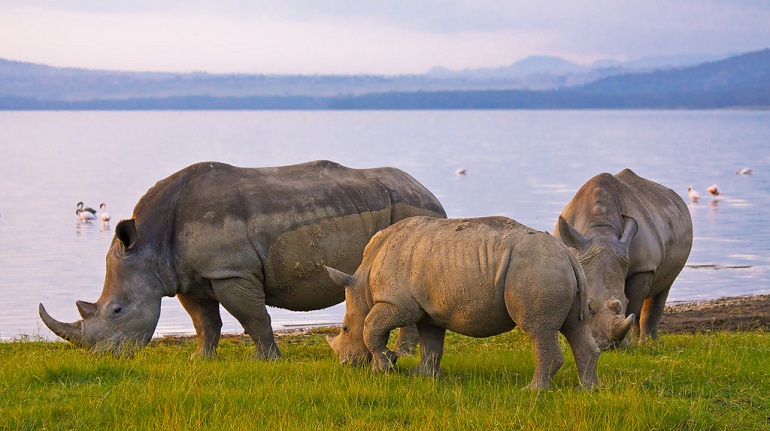
The ancestor of all modern rhinos was known as “Rhinocerotidae.” They first appeared in Eurasia in the Late Eocene era.
The earliest rhinos were much smaller, and there are believed to have been as many as 26 different species across North America and Eurasia until many of the smaller rhinos were wiped out by extinction events in the middle Oligocene period.
Despite this, many lineages were able to survive. One of these was the Menoceras, which had two side-by-side horns and was around the size of a pig. This species is believed to have died out around 5 million years ago. The last American rhinos also became an extinct species in the Pliocene period.
Modern-day rhinos are ancestors of Asian rhinos that lived during the Miocene.
Scientific Classification
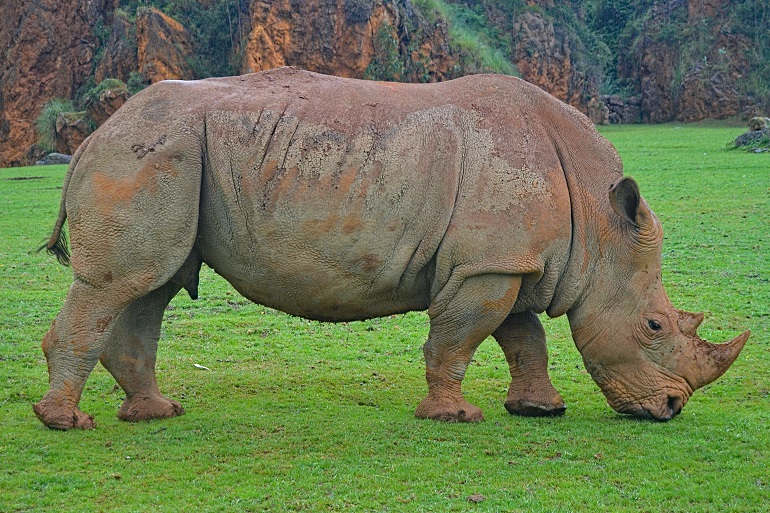
The rhinoceros taxonomic family is known as “Rhinocerotidae.” It consists of four genera: the White rhino (Ceratotherium), the Black rhino (Diceros), the Indian and Javan rhino (Rhinoceros), and the Sumatran rhino (Dicerorhinus).
All of these species alive today are split into three categories. Both African rhinos (Black and White rhinos) belong to the Dicerotini tribe, thought to have originated 14.2 million years ago, during the middle Miocene.
The Indian rhino and the Javan rhino are the only remaining relatives of the Dicerorhinini. They are thought to have diverged from each other about ten million years ago.
Species
Here are a few of the rhinoceros species:
Black
It’s quite confusing that the name Black rhinoceros was given to Diceros bicornis to distinguish it from Ceratotherium simum, the White rhinoceros – as both species are incredibly similar in color!
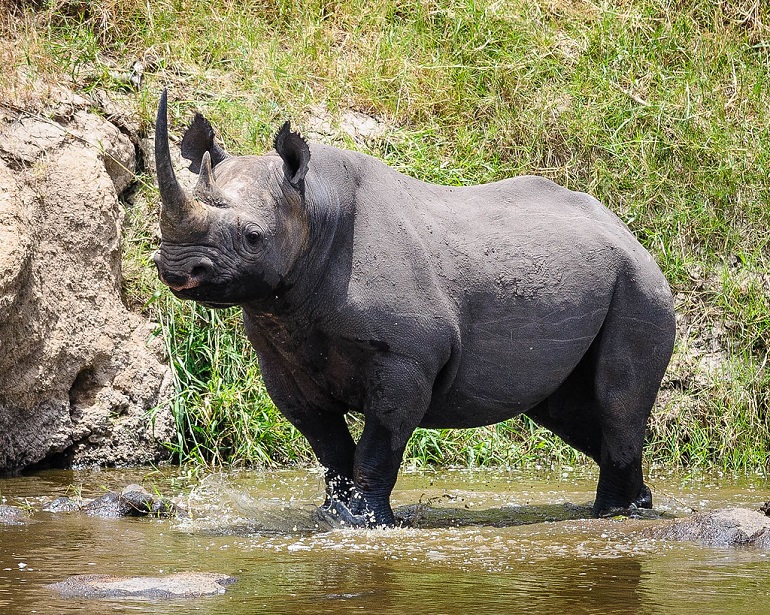
The Black rhinoceros includes four subspecies:
- Diceros bicornis minor – this species ranges through South-central Africa and is the most numerous
- Diceros bicornis occidentalis – this species is numerous in the Southwestern regions of Africa
- Diceros bicornis michaeli – East African, mostly found in Tanzania
- Diceros bicornis longipes – West African, which was unfortunately declared extinct in 2011
White
The White rhino is split into two subspecies – Ceratotherium simum simum (Southern white rhino) and the Ceratotherium simum cottoni (Northern white rhinos).
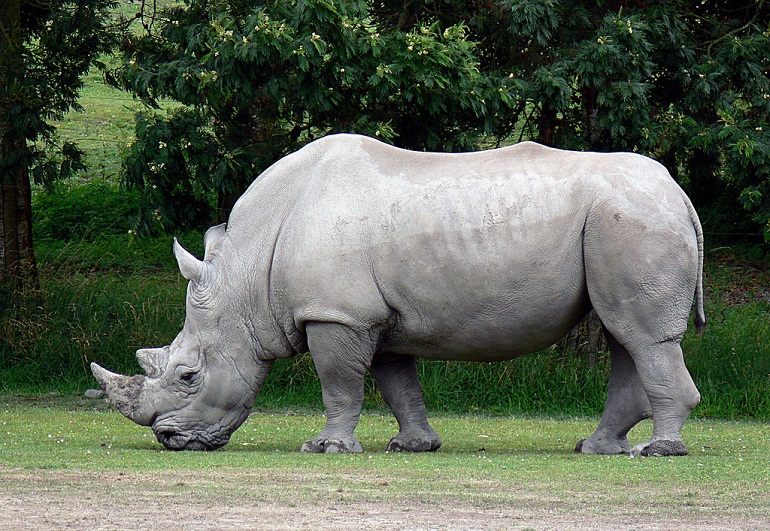
In 2011, there were believed to be more than 10,000 Southern white rhinoceros in the wild. This would mean they are the most numerous rhino species on the planet.
On the other hand, the Northern subspecies are critically endangered, with the remaining individuals in captivity.
Javan
Javan rhinos are among the most endangered large mammals on Earth. In 2015, it was believed that only about 18 individuals were left in Java. All of them are wild.
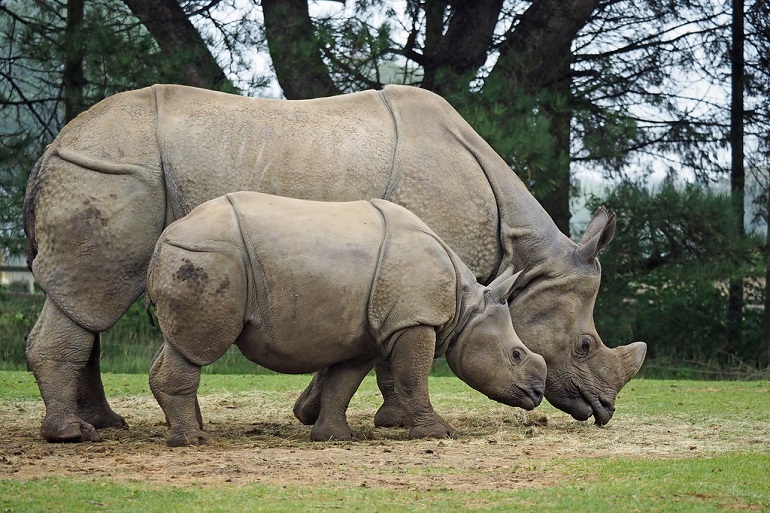
This species is also the least studied. It has an unusual appearance, with skin folds on its shoulder, rump, and back, which make it look like it has body armor.
Indian
The Indian rhino used to inhabit a large area from Myanmar to Pakistan and perhaps parts of China.
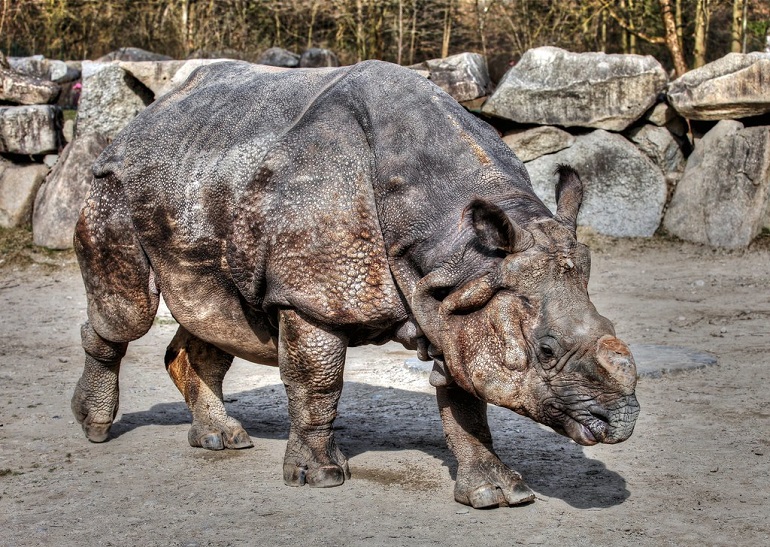
However, due to human activity, Indian rhinos now only live in protected areas of India and Nepal, and one pair lives in a national park in Pakistan after reintroduction. They all live in the forest and grasslands of the Himalayan foothills.
Sumatran
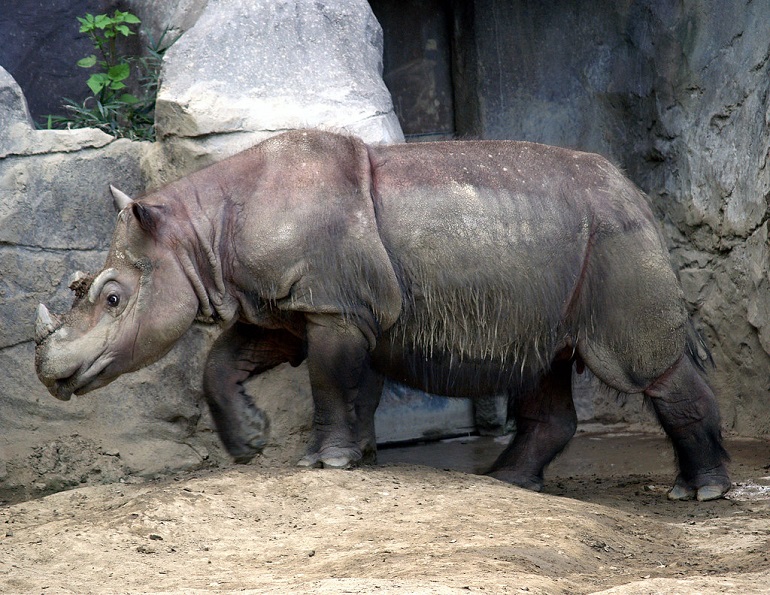
Sumatran rhinos are the smallest of all living species. They live in the high-altitude regions of Sumatra and Borneo. As a result of poaching and habitat loss, this species has declined in number to become the second most threatened species after the Javan rhinoceros. It is believed that only 30 individuals are left.
Predators, Poaching, and Hunting
Aside from humans, adult rhinos don’t have any natural predators in the wild. Young rhinos may occasionally be preyed upon by crocodiles, big cats, hyenas, and African wild dogs.
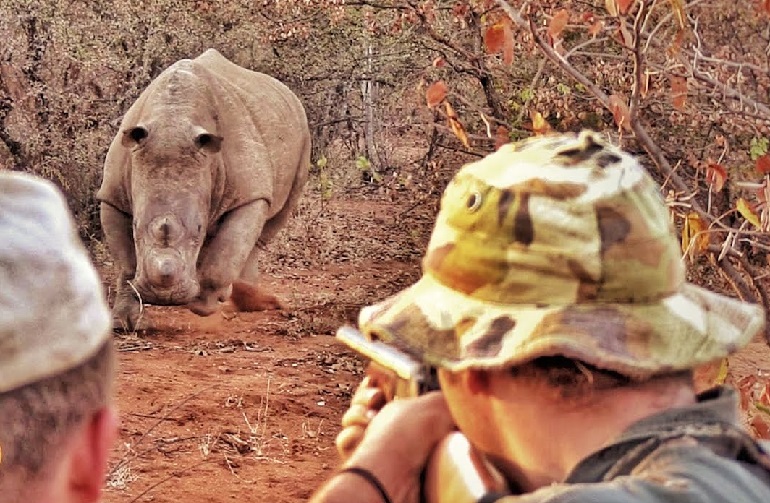
Unfortunately, while rhinos are large, powerful animals that have been known to be aggressive, they are easy targets for poachers. Rhinos will visit water spots daily, which puts them at risk of being killed as they take a drink.
In 2009, poaching rates had increased worldwide, and efforts to protect wild rhinos were ineffective. In fact, only 3% of poachers in Zimbabwe are successfully caught.
Sadly, poachers are getting more sophisticated in their practice. In South Africa, poachers were able to kill the last remaining female rhino within the Krugersdorp Park close to Johannesburg.
In 2010, around 400 rhinos were killed by poachers in South Africa, which rose to 751 in 2012, and 1349 in 2015. Sometimes the rhinos are drugged before their horns are removed, but in other cases, other body parts are also taken.
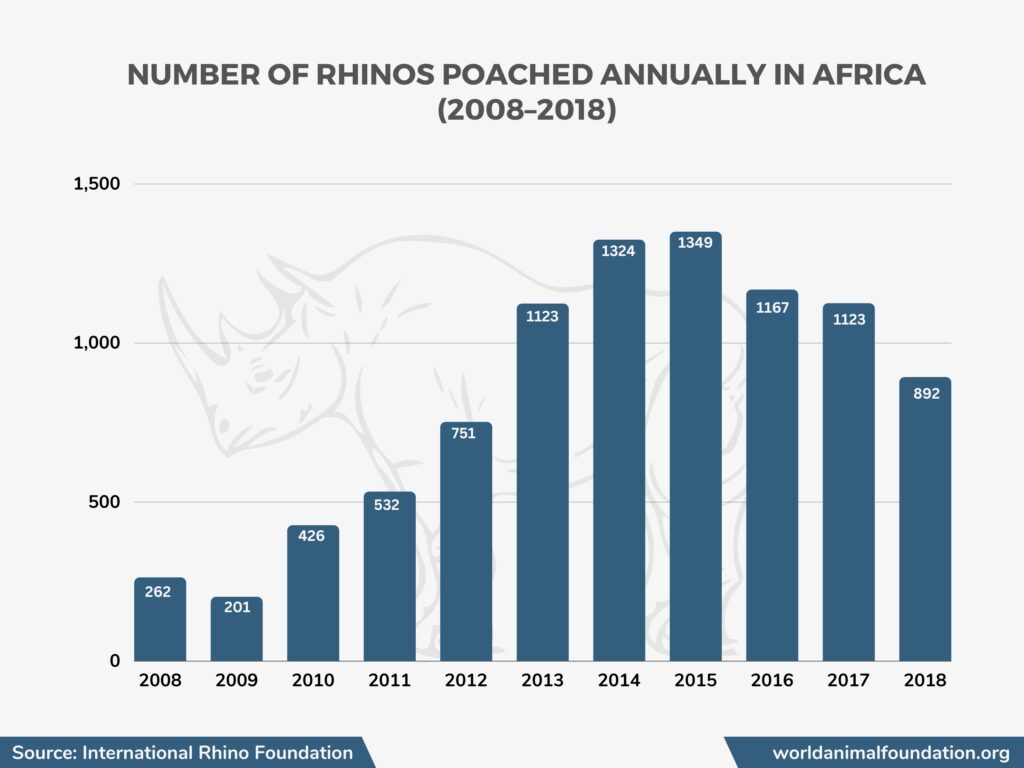
In Namibia, the government has approved the auction of 5 trophy hunting licenses for Black rhinos every year. The idea is that the money raised can be put towards conservation. However, many people disagree with this practice.
Horn Use
Rhino horns are made from keratin and develop from tissues beneath their skin.
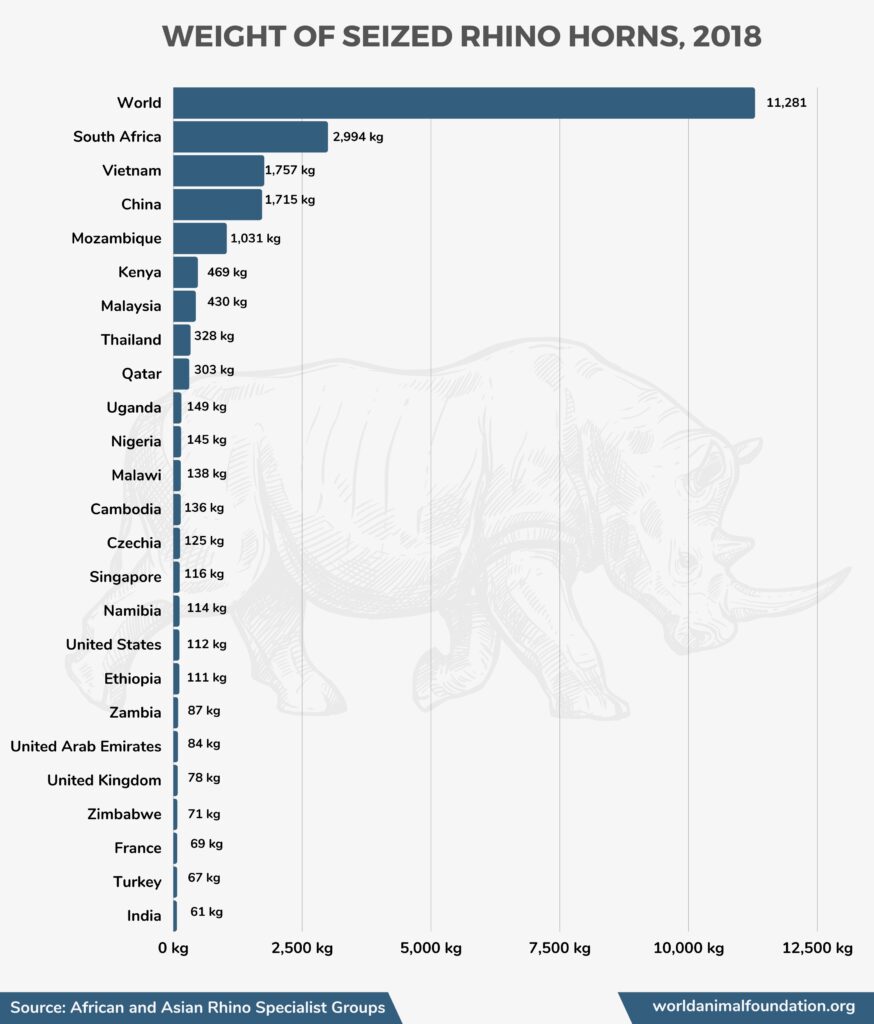
They are used in many traditional Asian medicines and to make dagger handles in Oman and Yemen. In Europe, people used to believe that rhino horn could purify water and detect poisonous liquid. It was also believed to have aphrodisiac properties and be an effective antidote to toxins.
Many people think powdered rhino horn is used as a cancer cure or aphrodisiac in traditional Chinese medicine, but no recorded text supports this. However, it is sometimes prescribed as a treatment for convulsions or fevers.
There is absolutely no evidence that rhino horns are an effective treatment for these conditions. In fact, it has been described as about as useful as drinking water mixed with nail clippings!
Fortunately, China signed the CITES treaty in 1993 and removed rhino horn from the pharmacopeia of Chinese medicine. The United Kingdom Register of Chinese Herbal Medicine also issued a formal statement in 2011, which condemned the use of rhino horn.
Thankfully, many traditional medicine practitioners are now speaking out against using rhino horn, although a few still believe it’s an effective cure.
Horn Trade
The international trade in rhino horns has been illegal since 1977, as declared by the Convention on International Trade in Endangered Species of Wild Fauna and Flora (CITES).
The sale of rhino horns in South Africa, where 80% of rhino populations live, was banned in 2009. However, this ban was legally overturned in a 2017 court case.
South Africa is planning to bring in regulations for rhino horn sales and may even allow exportation for non-commercial purposes. The theory behind this move is that the regulated sale of rhino horns could reduce the threat from poachers and conserve rhino numbers.
The largest number of rhino horn consumers is in Vietnam. It is this demand which drives the majority of poaching activity.
The Vietnam CITES Management Authority has in the past claimed that there had been a 77% drop in their consumption of rhino horns. However, as there hasn’t been an increase in criminal gangs being arrested, this figure has been disputed.
Some people think that regulating the sale of rhino horns is a good way to stop poaching, but most wildlife organizations disagree. The World Wildlife Fund doesn’t support this idea, as it believes it may actually increase demand for rhino horns and encourage hunting.
Rhinoceros Habitat and Diet
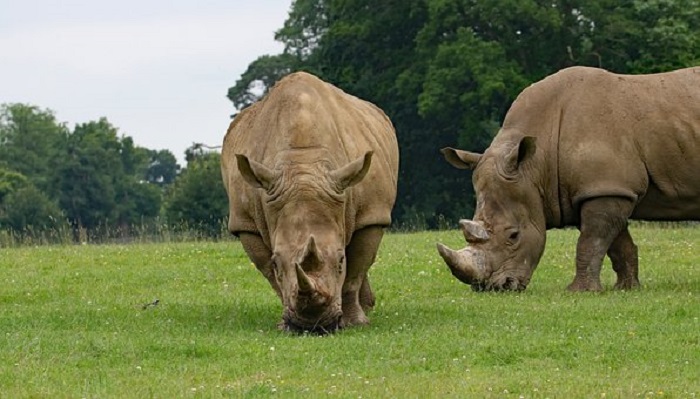
In the past, rhinoceros were present across large areas of Africa and Asia, but their distribution has reduced significantly in recent years. Nowadays, rhinos are found only in Borneo, Sumatra, the Eastern Himalayas, and parts of Africa.
Their habitat depends on the species. Sumatran rhinoceros prefer tropical and subtropical forests, while Black and White rhinos inhabit open grasslands.
All species of rhinos are herbivores, so they mainly eat vegetation. They spend most of their day grazing and browsing for grasses and plants to eat.
The types of plants that they consume differ depending on their habitat. Rhinos are among the few remaining “megaherbivores” – plant-eating animals weighing over 2000 pounds.
Rhinoceros Behavior
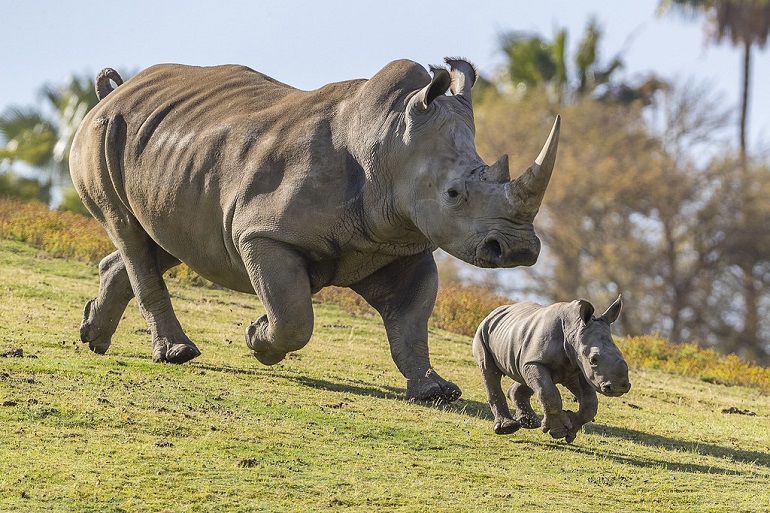
In Africa, the two species of rhino (black and white) inhabit home ranges that occasionally overlap. They may also share water holes, wallows, and feeding grounds with each other.
The Black rhinoceros tend to live a solitary lifestyle, while the White rhinoceros are happy to hang out with others. White rhinos have detailed social structures, sometimes living in groups of up to 14 individuals. These groups often include several females and their calves.
White rhinoceros adult males will defend their territories, which are usually around 1 square mile in area. They mark the boundaries of their range with smashed piles of dung!
All species of rhinos make a range of unique vocalizations, but White rhinos have the widest vocabulary. This is probably because they are the most sociable rhino species. After all, if you are living in a large group of individuals, it’s useful to be able to speak to each other.
Some research has shown that there are some recognizable differences between the sounds created by the Northern and Southern subspecies. Individual animals also have their own unique “voices.” Therefore, it’s likely that individuals can tell each other apart by their voices, even over long distances.
Rhinoceros Reproduction
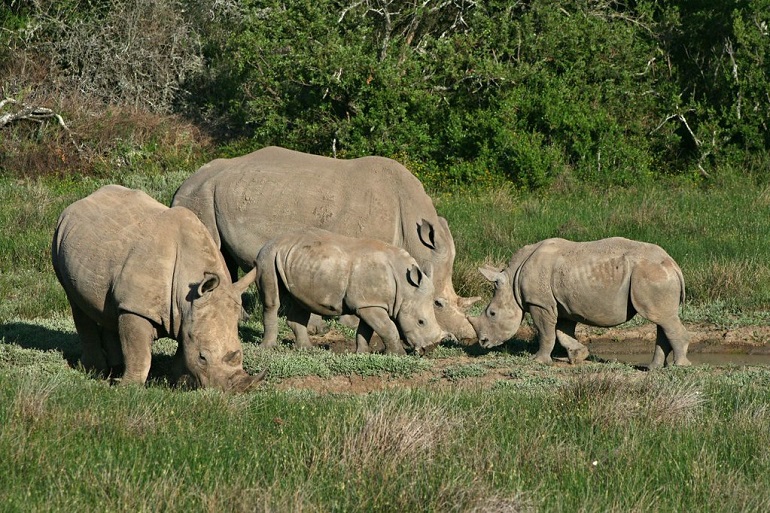
Female rhinos almost always have a single calf. Twins are incredibly rare. The calf can weigh more than 100 pounds! Rhino breeding patterns vary depending on the habitat and the particular species.
Mummy rhinos may stay with their calves for as long as four years unless she gets pregnant again during this time. If she has another baby, she will push her older baby into independence so that there’s space for her new arrival.
Sumatran rhinoceros are slightly different. They will only stay with their baby for 2-3 years, even if the female doesn’t have another baby. Captive Sumatran rhinoceros are notoriously difficult to breed. In the past 15 years, only two captive individuals have produced calves.
Due to their complex social structure, White rhinos display different breeding patterns. Females can have a home range that is 7x the size of males, but once they are fertile, the dominant male will prevent them from leaving his territory. Males will also fight over females, often getting badly injured in the process.
Characteristics of Rhinos
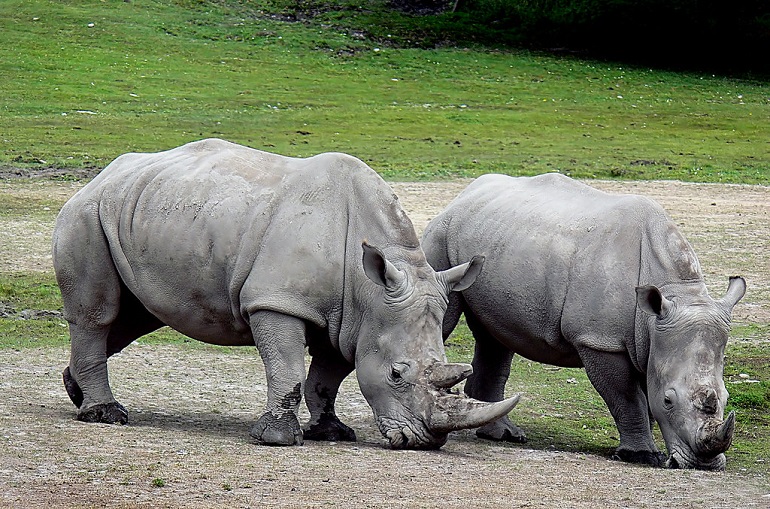
Rhinos are the second largest land animal after elephants. They have a cylindrical body, short legs, short tails, and big, robust heads.
Their most defining feature is their horns. The number and size of their horns varies across species. All species have at least one large horn, with some species also having a second, smaller horn.
Rhinos have thick skin that can appear like plated armor in some species. They are usually brown, black, or gray (even if one species is confusingly called a “white rhinoceros”)!
African rhino species are significantly larger than those found in Asia.
Conservation Status
The Javan rhinoceros is the most threatened species of all. They are listed as critically endangered, and only 18 mature individuals are believed to remain. The Sumatran rhino is also registered as a critically endangered species, with an estimated population of only 30 individuals left.
One-horned rhinos are one species that has previously come incredibly close to extinction. At the beginning of the 20th century, only around 200 wild individuals were left. As a result of conservation efforts, nowadays, there are around 21,000. They are still classed as vulnerable but have been brought back from the brink.
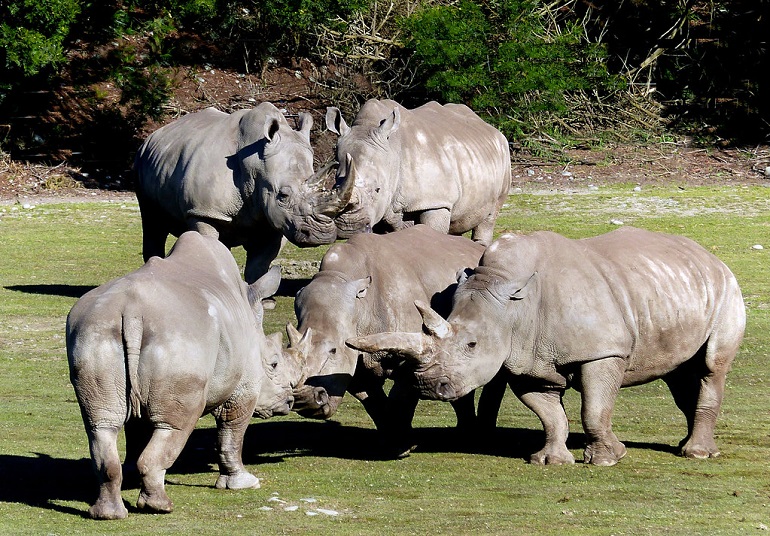
Black rhinos are classified as critically endangered. Their numbers have doubled over the past 20 years, but there are still dangerously few individuals for a stable population.
White rhinos are the only rhino species not to be classified as endangered. The remaining rhino population is believed to be around 10,000, which makes them a “near threatened” species.
However, the Northern White rhinoceros, a subspecies of the White rhinoceros, are on the brink of extinction. The last male individual died in 2018, while the last two females in captivity are now too old to reproduce.
Therefore, our only chance of saving the Northern White rhinoceros is to use in-vitro fertilization. Attempts are continuing, but a viable pregnancy via surrogate is yet to be achieved.
Ways to Prevent Poaching
Below are some ways to stop poaching:
Horn Removal
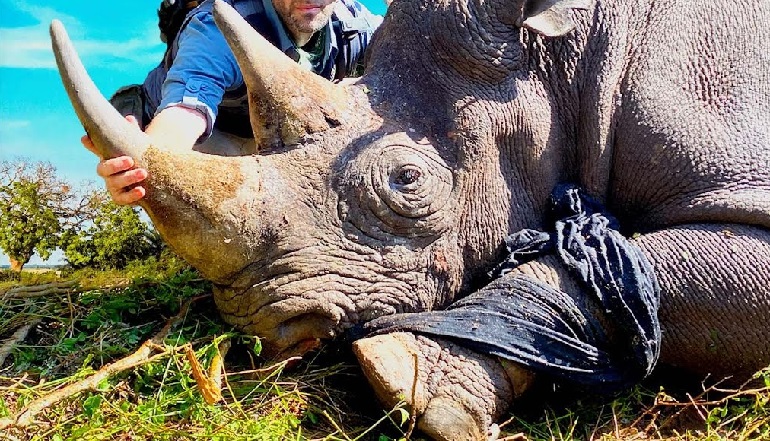
In some countries, rhinoceros have been tranquilized and had their horns removed as a way to deter poachers. This process has been successful in many areas but is not a complete solution.
In Hwange National Park in Zimbabwe, most of the dehorned rhinoceros were still killed by poachers within 2-years of being dehorned. In another area of Zimbabwe, 6 dehorned rhinos were killed by poachers soon after their horns were removed.
Unfortunately, dehorning needs to be used in conjunction with effective anti-poaching security to be truly effective. Poachers will still kill dehorned rhinoceros to claim the remaining horn stump or simply murder them out of spite.
Horn Poisoning
The Rhino Rescue Project attempted to control the rhinoceros horn trade by infusing live rhinos’ horns with a combination of pink dye and tick poison. This mixture is harmless to the rhinos but toxic to people.
Interestingly, this doesn’t turn the horn pink, as it is infused into the inside of the horn.
The idea is that anyone who consumes powdered rhino horns that have been treated will feel very sick but not die. Signs are also placed around reserves to notify potential poachers that the rhinoceros have been treated.
However, while this treatment may have some positive impact, this approach has practical issues. Firstly, poachers and linked criminal organizations are unlikely to care about the health of their buyers. Secondly, many people purchase rhinoceros horns for decorative purposes, not consumption.
Artificial Substitute for Rhinoceros Horn
Matthew Markus, from a biotechnology firm called Pembient, has suggested creating artificial rhino horn as a substitute for the real thing.
The “fake” rhinoceros horn would have a registered genetic code that can be distinguished from a real horn by relevant authorities.
This suggestion has not been trialed, but some conservationists believe it could be a useful tool in the future.
Rhinoceros Discoveries and Fossils
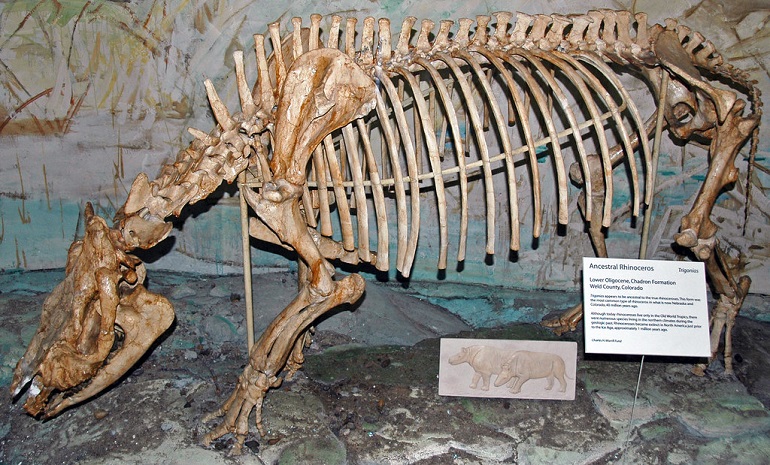
In 2015, a team of paleontologists in China discovered a prehistoric species of giant rhinoceros in Gansu Province. This huge fossil is believed to have been the largest land mammal ever to walk the Earth.
It is thought that this giant rhinoceros weighed around 24 tons and was as large as 6 elephants!! The fossil was 26 feet long, and the creature’s head would have been 23 feet above the ground.
Rhinos vs. Hippos. What Are the Differences?
Rhinoceros are easily recognized by their large keratin-based horn. They have large cylindrical-shaped bodies, big heads, short necks and legs, and broad chests. They browse for food on land.
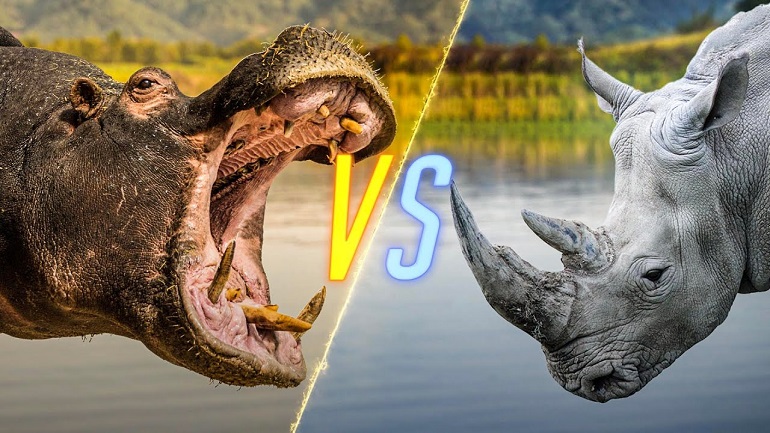
Hippos do not have horns. They spend much time in the water, although they will come onto land to graze. They have an almost completely hairless, rounded body, very large mouths, long teeth, and stubby legs.
Reasons Why Rhinos Are Endangered
The Javan rhinoceros is the most endangered species of all rhinos. They are only found in one protected area. This species is very vulnerable to habitat loss, poaching, disease, natural disasters, and inbreeding.
Sumatran rhinoceros are the second most threatened rhino species. This type of rhino has seen a decline in numbers due to habitat destruction. Their limited numbers and fragmented population also make it difficult for them to locate mates for breeding.
African rhinoceros species are most threatened by the illegal rhino horn trade. However, habitat loss and encroachment of human developments have also impacted their numbers.
How Many Rhinos Are Left in the World?
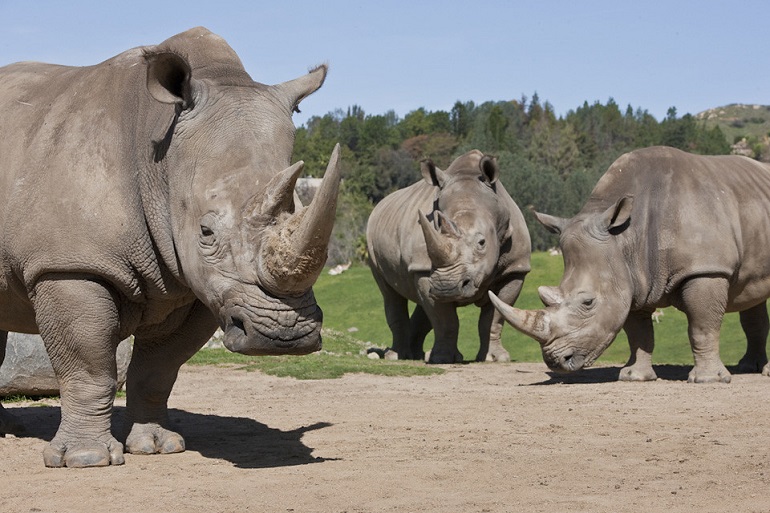
Rhinoceros used to be very populous across Asia, Africa, and Europe. They have even been depicted in ancient cave paintings.
Sadly, there are far fewer rhinoceros left today. At the start of the 20th century, it’s believed half a million rhinos lived in Africa and Asia. However, by 1970, the total rhino population had dropped to 70,000, and it’s thought there are as few as 27,000 individuals left today.
How Zoos Are Helping Rhinos
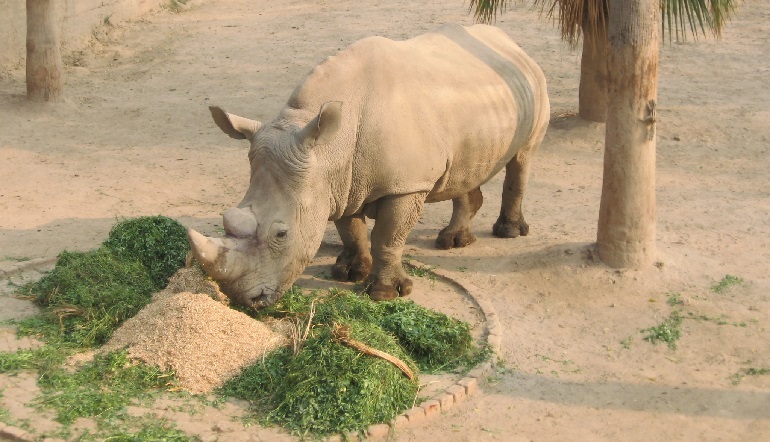
Zoos have a critical role to play in rhino conservation. Organizations such as the International Rhino Foundation work closely with many zoos to ensure that individuals are well cared for.
Zoos can work with the public to raise awareness, as well as funds, to support research and conservation action. The Wilhelma Zoo in Stuttgart has donated $100,000 to a Sumatran Rhino Rescue Project, even though they will almost certainly never have one of these animals in their collection.
Aside from raising funds, zoos allow people to come face-to-face with these extraordinary animals. Few people can afford a safari trip, so being able to see a rhinoceros in the flesh is a great way to inspire the public to do all they can to support their plight.
Zoos also undertake breeding programs, which are becoming more critical to prevent the extinction of threatened species such as the rhinoceros.
FAQ’s
Is a Rhino’s Nose Prehensile?
“Prehensile” refers to something capable of grasping, just like a human hand or a giraffe’s tongue, for example.
A rhino’s nose is not prehensile. It cannot use its nose to grab hold of things.
However, the Black rhinoceros does have a prehensile upper lip. As this species has no front incisors, it must use its lips to grasp leaves and pull them into its mouth.
Are Rhinos Dangerous?
Rhinos may be very large, rather intimidating animals, but they’re rarely aggressive if left alone.
Most rhinoceros are happy to roam around peacefully, grazing or foraging as they go. So long as they are left undisturbed, a rhino has little reason to attack humans.
However, females with calves are naturally more protective of their young and will charge if they feel threatened.
How Long Is a Rhino’s Gestation Period?
Rhinos have one of the longest gestation periods of any land mammal. They are pregnant for around 16 months, but they can sometimes carry a calf for up to 18 months!
Elephants are the only mammal with a longer gestation period. The largest species carries its young for up to 23 months.
Their long gestation period is certainly amazing, but it also poses a problem for the rhinoceros population. As numbers decline due to poaching and habitat destruction, the gestation length means it can take a long time for the population to recover from losses.
Is a Rhino a Herbivore?
All rhinoceros species are herbivores. These large mammals like to spend the bulk of their day grazing the plains or foraging their habitat for plants and tasty grasses.
How Can I Help Rhinos?
The number one thing you can do to help rhinos is boycott rhinoceros products. Never buy these items, and make sure to tell everyone you know not to buy them either. The illegal trade in rhino horn is the biggest threat to these magnificent creatures.
You can also support rhinoceros conservation by adopting a rhino through a registered organization such as the WWF-US or WWF-UK to help them fight endangered species in UK.
Another great way to support rhinos is to buy sustainable products that do not contribute to illegal logging and further habitat loss. Choose FSC-Certified and sustainable palm oil products wherever possible.
You can also donate to charities such as Save the Rhino, The Sumatran Rhino Rescue Project, and the International Rhino Foundation.
Conclusion
With their large bodies, impressive horns, and prehistoric appearance, rhinos are incredible animals. They have walked this Earth since the late Eocene era and have even been found in ancient cave paintings.
Unfortunately, these majestic creatures are under serious threat from humans. All known rhino species are now threatened, with some species on the brink of extinction. We could lose them forever if we do not act to save rhinos.
Have you adopted a rhinoceros or taken part in a wildlife conservation project? Let us know in the comments below.


